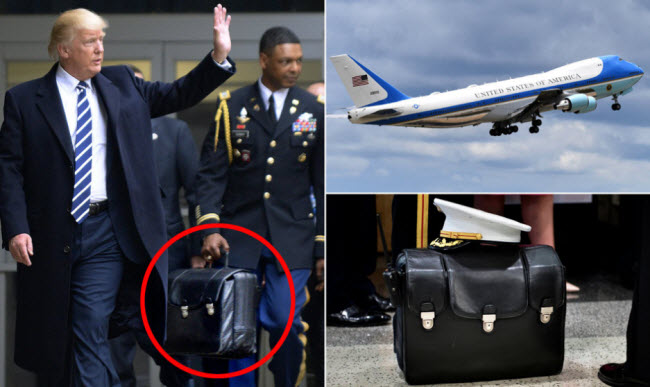The nuclear football is a briefcase whose contents can authorize the U.S. President to launch a nuclear attack when away from fixed command centers like the White House Situation Room or the Presidential Emergency Operations Center. It contains retaliatory strike plans and codes to activate U.S. nuclear weapons stationed globally. Its significance lies in its role as a mobile hub in the U.S. strategic defense system. The nuclear football is always carried by a military aide accompanying the president on both domestic and international trips. It is sometimes referred to by other names such as the “president’s emergency satchel,” the “black box,” or the nuclear football.
History of the Nuclear Football
The nuclear football dates back to President Dwight Eisenhower, but its current use came about after the Cuban Missile Crisis when President John F. Kennedy was concerned that a Soviet commander in Cuba might launch nuclear missiles without authorization from the Soviet Union. Kennedy posed several questions about launching U.S. nuclear weapons, asking whether he could issue such orders without consulting the Secretary of Defense or the Joint Chiefs of Staff. These concerns led to the development of procedures that are still followed today.
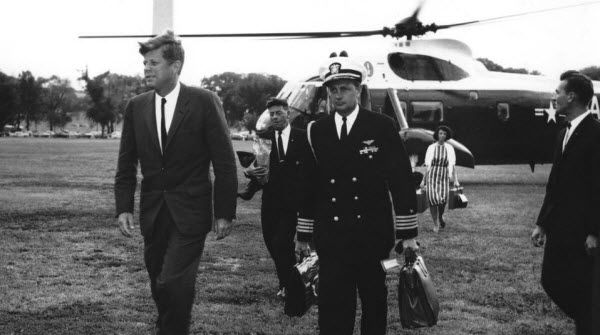
The football’s nickname, nuclear football, is said to be derived from a nuclear attack plan with the code name “Dropkick,” an American football term. This name caused some confusion about the nature of the briefcase, which is just a regular leather bag, larger than any known ball and unrelated to the sport.
During their presidencies, Jimmy Carter and Ronald Reagan preferred to keep nuclear launch codes in their jacket pockets. One of the aides who carried the nuclear football for both presidents was future Congressman John Kline, who later represented Minnesota in the U.S. House of Representatives from 2003 to 2017.
The nuclear football has seen some dramatic moments. During the 1981 assassination attempt on President Reagan, the nuclear codes were separated from him when his emergency room team removed his clothing after he was seriously injured. The codes were later found discarded on the floor of the emergency department. This incident gave rise to the urban legend that Reagan carried the codes in his sock during the incident.
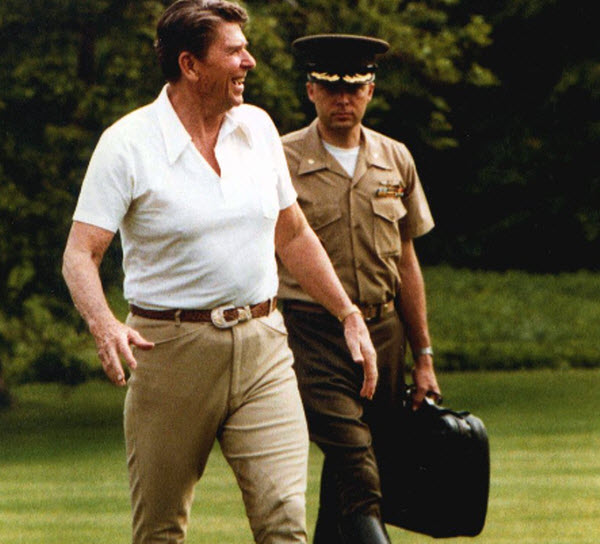
In another notable event in 1973, President Richard Nixon distanced himself from the nuclear football for about 30 minutes while joyriding with Soviet leader Leonid Brezhnev in a Lincoln Continental at Camp David. Similarly, other U.S. presidents, including Gerald Ford, Jimmy Carter, George H. W. Bush, and Bill Clinton, have been separated from the briefcase during different incidents.
The football became a topic of discussion again in February 2017 when a guest at President Trump’s Mar-a-Lago resort posed for a photo with the military aide carrying the nuclear football. The image, posted on Facebook, was taken around the same time that news broke about a North Korean ballistic missile launch. In November of the same year, during a visit to China, there were reports of a brief scuffle between U.S. military aides, including the nuclear football carrier, and Chinese security officials.
Another significant event involving the nuclear football occurred on January 6, 2021, during the Capitol riot. Security footage showed Vice President Mike Pence being evacuated with the nuclear football, which was only 30 meters away from rioters. Had they seized it, sensitive intelligence regarding pre-planned nuclear strike options could have been compromised.
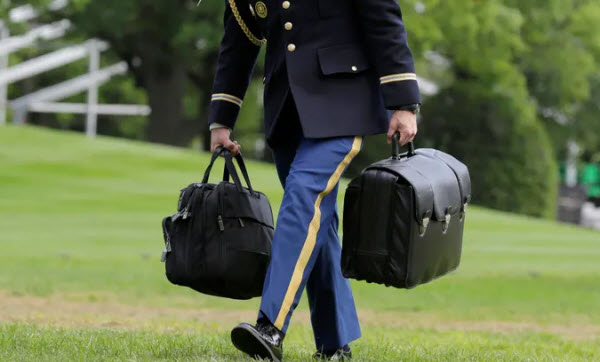
Contents of the Nuclear Football
According to Bill Gully, former director of the White House Military Office, the nuclear football contains four items:
- A black book (23 x 30 cm), with 75 pages printed in black and red, detailing retaliatory strike options.
- Another book listing target sites and alternative locations where the president can be taken in an emergency.
- A Manila folder with eight to ten stapled pages describing the Emergency Broadcast System procedures.
- Three index cards with nuclear activation codes.
In a 2005 Washington Post article, it was noted that a military aide always accompanies the president, carrying the nuclear football and launch codes. It was described as either a metallic briefcase or a leather bag weighing around 20 kilograms, containing a communication device.
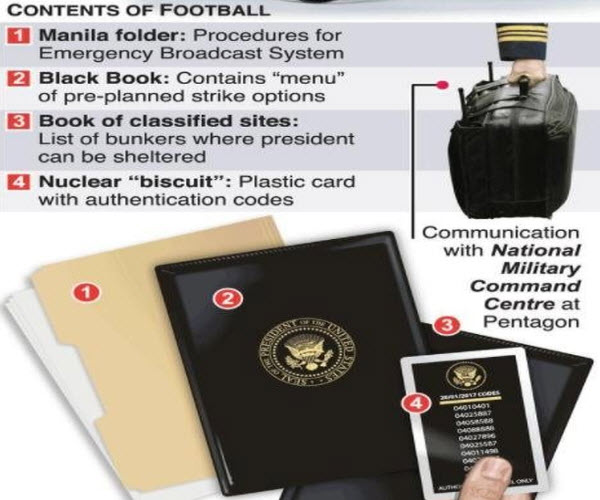
Mission of the Nuclear Football
If the President of the United States decides to authorize the use of nuclear weapons, the military aide opens the nuclear football. A command signal or alert is sent to the Joint Chiefs of Staff, and the president reviews attack options with the Secretary of Defense and the Chairman of the Joint Chiefs of Staff. After making a decision, a second round of communication occurs with the National Military Command Center and NORAD to prepare for a preventive strike and assess the possibility of a second strike.
For the order to be executed, the president’s identity must be verified using a code from a plastic card called the “cookie.” While only the president can order a nuclear strike, the Secretary of Defense must confirm the order, although they do not have veto power. Once confirmed, the nuclear launch order is transmitted down the chain of command to forces in the field, who control the nuclear weapons.
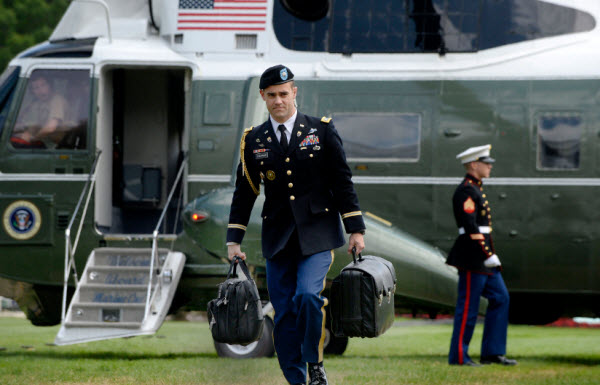
Although the president has supreme authority to order a nuclear strike, military officers are required to refuse any unlawful orders, including those violating the laws of armed conflict. Thus, the Chairman of the Joint Chiefs of Staff and other military personnel must reject any unlawful orders. Nonetheless, if the president determines that a decision is in the national interest, they can replace a chairman who refuses to execute their order. Additionally, the legality of the president’s orders is scrutinized by legal advisors to ensure compliance with the law.
Nuclear Briefcases in Other Countries
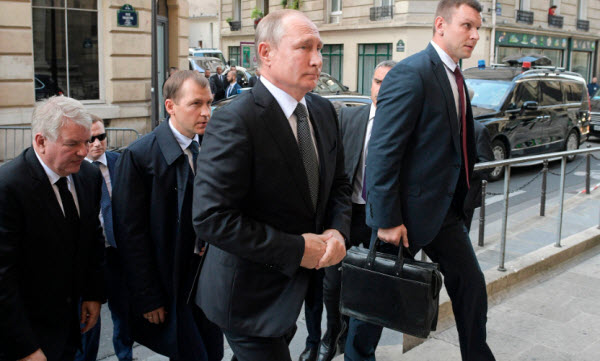
Other nuclear-armed nations have similar briefcases. In Russia, the nuclear football is called the Cheget, which is part of a communication system called Kazbek. It links senior officials involved in decisions regarding nuclear weapons use.
In France, there is no official nuclear briefcase, but a “mobile base” follows the president on trips, though it is not specifically tied to nuclear force. India also lacks a nuclear briefcase. The Nuclear Command Authority (NCA) must collectively authorize the use of nuclear weapons, with the Prime Minister heading the political council and the National Security Advisor leading the executive council. In Pakistan, footage revealed former Prime Minister Imran Khan carrying a black briefcase believed to contain Pakistan’s nuclear codes.
